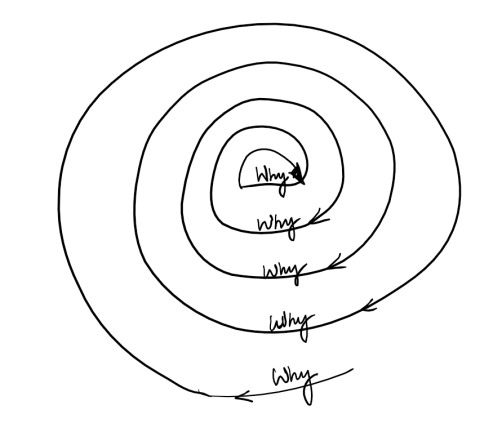Taiichi Ohno, the father of Toyota’s production system, instituted a technique called 5 Whys. It involves nothing more than asking 5 Whys in succession whenever a problem is found, just as an inquisitive toddler does.
This technique seems almost too simple to be of any use. When I first came across it, I paid no attention to it. However, it can make a world of difference when applied correctly and take us to the root cause of a problem.
For instance, I had written about how medical science treats symptoms rather than an underlying cause. Now let us apply the 5 Whys to a hypothetical stomach ache.
1. Why does my stomach ache?
Because I ate three cup-cakes after lunch at my table at work.
2. Why did I eat so many cup cakes?
Because I was stressed out. It seemed like a quick reward.
3. Why was I stressed out?
Because my manager keeps piling up work on my plate.
4. Why does my manager keep increasing my work?
Because he seems to have forgotten about the second project I started a week ago.
5. Why have I not reminded him about my second project?
Because I do not find enough time with him to sustain ongoing communication
In this example, the root cause of a stomach ache was actually a communication issue. Physicians, as I had argued earlier, often do not even ask the first “Why”. And rightly so, because it in several cases the cause is none of their business. Besides, taking a pill seems to cure one stomach ache, while encouraging several others by allowing us to escape its consequences. But getting to the root cause of an ache can potentially prevent several others that follow.
Coming back to how simple this technique is, it is important to distinguish between simple and easy here. 5 Whys is a simple technique. But its application can be surprisingly difficult.

GOOD food for thought
LikeLike
I have a hunch that this technique will set people up for causal fallacies if they are not careful.
Here is a bunch of them from Wikipedia – https://en.wikipedia.org/wiki/Category:Causal_fallacies
To elaborate in somewhat abstract terms –
– I am in point A.
– How did I get to point A? Possibly very many, but this set is constrained by my current conditions in point A.
– Out of say n possibilities of getting to point A, I pick one (point B).
– You repeat this process 5 times (from point B to C and so on).
If you use a proper statistical approach to this, you can go back to the original cause with a high probability. If you don’t, maybe because you fell for any of the causal fallacies at any step, there is a risk of assigning a wrong cause,
LikeLiked by 1 person
Thanks Bala!
What you have pointed out is true, and raises a very important point. Little wonder that 5 Whys actually started on shop floors, where there is a high availability of statistical data to analyze and get to an accurate result. Therefore, applying to our own lives, requires us to quantify them.
The first step would be to start asking the whys, and the second, then, would be to design experiments to answer them accurately.
Also, that list of fallacies is huge!
LikeLike
Yes, that is just a list of causal fallacies. Have a look at the list of cognitive biases – https://en.wikipedia.org/wiki/Category:Cognitive_biases
The funny thing about applying 5 Why’s in the wrong way is that with each why, your mind becomes more certain about the cause, but statistically, it gets worse (because your are multiplying fractions). Similar to the conjunction fallacy – https://en.wikipedia.org/wiki/Conjunction_fallacy
LikeLike